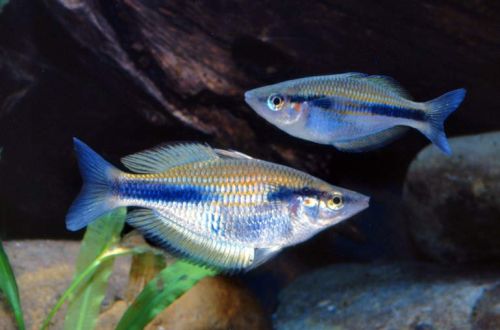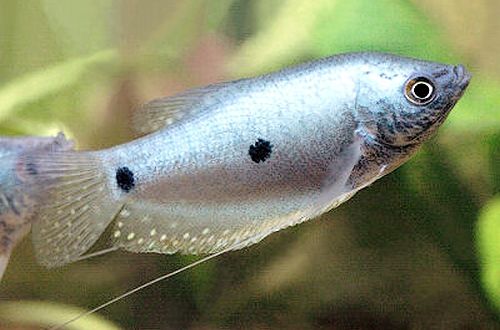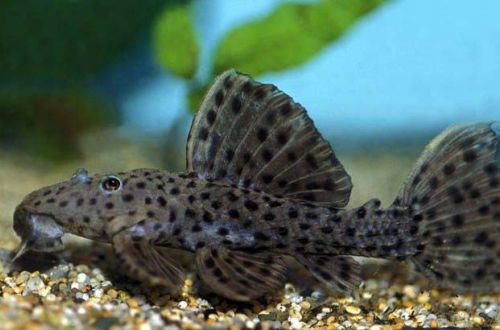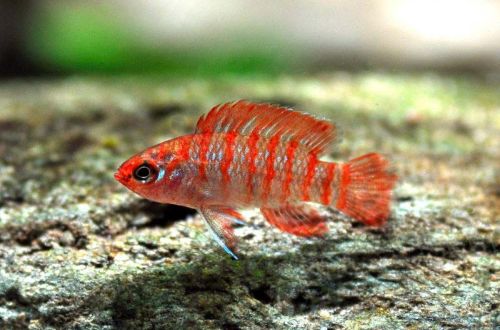
Melanotenia Goldi
Melanothenia Goldie, scientific name Melanotaenia goldiei, belongs to the family Melanotaeniidae (Rainbows). The fish is named after the area in which it was first discovered – the Goldie River in Papua New Guinea. Known in the aquarium trade since the 1950s, it became popular in Europe after the famous German explorer Heiko Bleuer brought a new species of fish called the Tapini to the continent in the late 1980s.

Contents
Habitat
The fish comes from the southern part of the island of Papua New Guinea. It is found everywhere, the natural habitat includes swamps, backwaters, small streams and large rivers. A typical biotope is a poorly lit reservoir with a slow current and an abundance of aquatic vegetation, the bottom of which is covered with a layer of fallen leaves and polynomial snags.
Brief information:
- The volume of the aquarium – from 150 liters.
- Temperature – 22-33°C
- Value pH — 7.0–8.0
- Water hardness – 15–22 dGH
- Substrate type – any dark
- Lighting – subdued
- Brackish water – no
- Water movement – light or moderate
- The size of the fish is about 10 cm.
- Food – any food
- Temperament – peaceful
- Content in a group of 6-8 individuals
Description
Adults reach a length of up to 10 cm. Males and females look the same, but the latter are somewhat smaller. The color is replete with a variety of colors, but blue shades predominate. A black stripe stretches along the body, narrowing or dissolving in the middle.
Food
In nature, it feeds on small insects, their larvae, crustaceans and other zooplankton. In a home aquarium, similar live or frozen foods should be served, as well as dry foods rich in protein. It feeds in the upper and middle layers of water, the remains of food from the bottom will not be eaten.
Maintenance and care, arrangement of the aquarium
Optimal conditions for keeping Melanothenia Goldi are achieved in a spacious aquarium in an environment that resembles a natural natural reservoir. The design should provide for open areas for swimming and places for shelters in the form of floating plants, branched snags and other natural or artificial decor. Use dark design elements, including the ground. The lighting is subdued. They can jump out of the aquarium, so a lid is a must.
Fish prefer soft, slightly alkaline water. To maintain biological balance, it is necessary to regularly clean the aquarium from organic waste, replace part of the water (20–30% of the volume) with fresh water weekly, and carry out equipment maintenance.
Behavior and Compatibility
Males often chase females during spawning. Such “courtship” is sometimes overly persistent. If the female has nowhere to hide, then the chase can end sadly. It is recommended to purchase a mixed group, where there will be 2-3 females per male. Otherwise, no intraspecific conflicts were noted. Peacefully tuned in relation to other species, compatible with non-aggressive fish of comparable size.
Breeding / breeding
The breeding season in the artificial environment of aquariums is not pronounced. Females lay eggs in dense thickets of plants, fixing them on leaves. The fry appear within a week. Parents do not show interest in juveniles, however, for the safety of offspring, it is desirable to transplant it into a separate tank. Feed micro foods, such as brine shrimp nauplii, finely ground dry flakes, special foods for aquarium fish fry.
Fish diseases
In a favorable environment, cases of the disease are rare. When the first symptoms of the disease appear (lethargy, deformation of the body, the appearance of spots, etc.), it is first necessary to check the quality of the water. Probably, bringing all indicators of the habitat back to normal will allow the body of the fish to cope with the disease on its own. Otherwise, medical treatment will be required. Read more in the section “Diseases of aquarium fish”.





